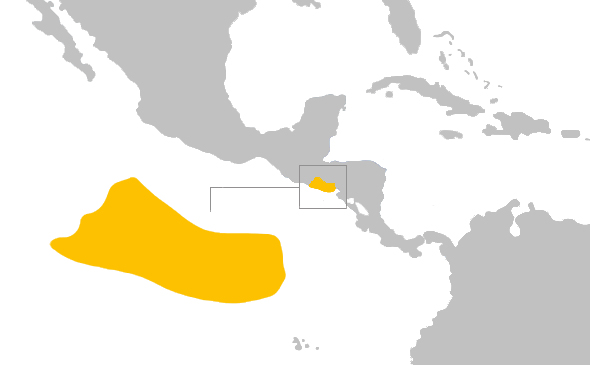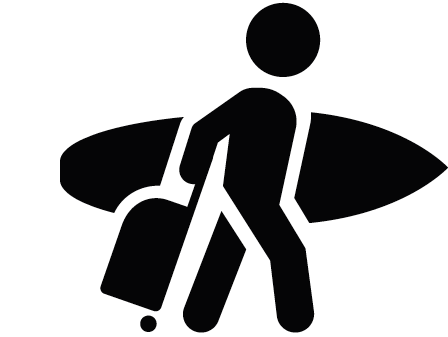Surfing in El Salvador

El Salvador is the smallest country in Central America but has huge potential as one of the best surf destinations in the world. The country is known for being a regular footer paradise with numerous right-hand world class point breaks scattered all over the 307km of coastline. La Libertad is located in Costa del Balsamo just 40 km down south from the capital San Salvador and it’s the main surfing area in the country. There you will find the famous Punta Roca, considered the best and longest wave in El Salvador. Most of the surf spots in the city of La Libertad can get crowded especially during the weekends due to the proximity to the capital but there are many other quality point breaks to be explored in this area. Since most of El Salvador’s coastline is facing to the south, the best swells are from south and southwest. This means that the best months to visit the country are March and April, which are the last months of the dry season. This is when south and southwest swells are consistently hitting the shores of the country creating great surf conditions. In the past El Salvador suffered from a terrible civil war and that's probably why the country hasn’t been so popular among the surf community but recently El Salvador has been considered safe again to be visited and the outstandingly welcoming population is more than happy to host the tourists and leave the bad memories in the past. Besides surfing, travelers can enjoy many natural beauties like the stunning beaches, the mighty volcanoes, abundant mango trees and green lush coffee plantations.
Climate in El Salvador
The climate in El Salvador is tropical with two very distinct wet and dry seasons. The rainy season or summer extends from May to October. During this time of the year rainfall usually comes from low pressure zones over the Pacific and most of the time happens in heavy afternoon thunderstorms. Pretty much all the annual rainfall occurs during this time of the year. El Salvador is quite protected from the hurricanes that form in the Pacific Ocean but still can suffer the effects of major tropical storms. This is the best time of the year for those who are looking for constant big waves. Dry season is from November to April and this is when the northeast trade winds prevail. During these months the warm winds that reach El Salvador makes the weather dry, hot, and hazy. At the tail end of the dry season it starts to rain again but still not very intensely. The weather it’s a bit cooler and this is when the first south swells of the year reach the coast and start to pump all point breaks of El Salvador. Late March/early April is considered a great period to visit the country according to most of the local surf guides.
Best surf spots in El Salvador
El Salvador is a regular footer paradise with lots of perfect right-hander pointbreaks. Here are the best surf spots in the country: Barra de Santiago, Bocana, Cocal, Cristo de Salinitas, El Palmarcito, El Pimental El Sunzal, El Zonte Beach, El Zonte Point, K59, Km 61, Las Flores, Mizata Point, Punta Mango, Punta Remedios, Punta Roca, San Blas and Toro de Oro.
Budget Planning
Meal price range
Simple meals start at $1 USD. Mid-range meals start at $8 USD. Dining & drinking at high-end restaurants can cost anywhere from $25-35 USD
Equipment rental
Boards are $15 USD a day.
Prepaid SIM cards
Tigo is a good choice. SIM cards can be purchased from shops, supermarkets, kiosks, pharmacies, official stores and at El Salvador International Airport.
Prepaid packages start at $3 USD.
Public transport
Buses are the primary way to get around the cities as well as the country as a whole.
In most touristy areas you’ll find small tour offices that sell seats on minivans or minibuses. They’ll take you just about anywhere you need to go in the country (and onward into neighboring countries).
Taxis are easy to find, although in smaller towns they take the form of tuk-tuks. Most are unmetered, so make sure you negotiate your price beforehand. Tuk-tuks are the cheapest option, and you can get a few blocks for less than $1 USD. A taxi from the airport to San Salvador or El Tunco is between $25-35 USD.
Gas prices
$0.55 USD a liter.
Types of risks
Apart from a serious mosquito problem around Zunzal, El Salvador’s biggest hazards are the rocky shorelines around many of the pointbreaks, especially at Punta Roca, where the rocks get really slippery.
How to prepare
Visa
Citizens from 86 countries, including the EU, US, and Australia, can enter El Salvador without a visa for up to 90 days.
Vaccines
Although it's not mandatory, it’s recommended that you have been vaccinated for hepatitis A & B, yellow fever, typhoid, rabies, meningitis, polio, Tdap, chickenpox, shingles, pneumonia, influenza, measles, mumps and rubella. You’ll be asked to show proof of your yellow fever vaccination if you come from a country with a risk of yellow fever.
Things to know
Language & Currency
Spanish is the official language. You’ll find English speakers in the more touristy areas.
The currency is US dollar (US$).
Best time to go
March and April.
Checking Surf forecast
Checking the forecast about a week before your trip is always a good idea. Understanding what the waves will be like and knowing what gear to pack is essential. You can check the forecast for the waves here.
Do I need pack a pharmacy kit
You should bring a basic kit. Including ear drops, eye drops, bandaids, ear plugs, gaze, alcohol, mosquito repellent and broad spectrum antibiotic ointment.
Travel/Surf Insurance
World Nomads has great travel insurance packages that are not super expensive and they cover surfing.
Emergency
Dial 911 for emergencies
Check surf pictures of El Salvador at #surfingelsalvador.

